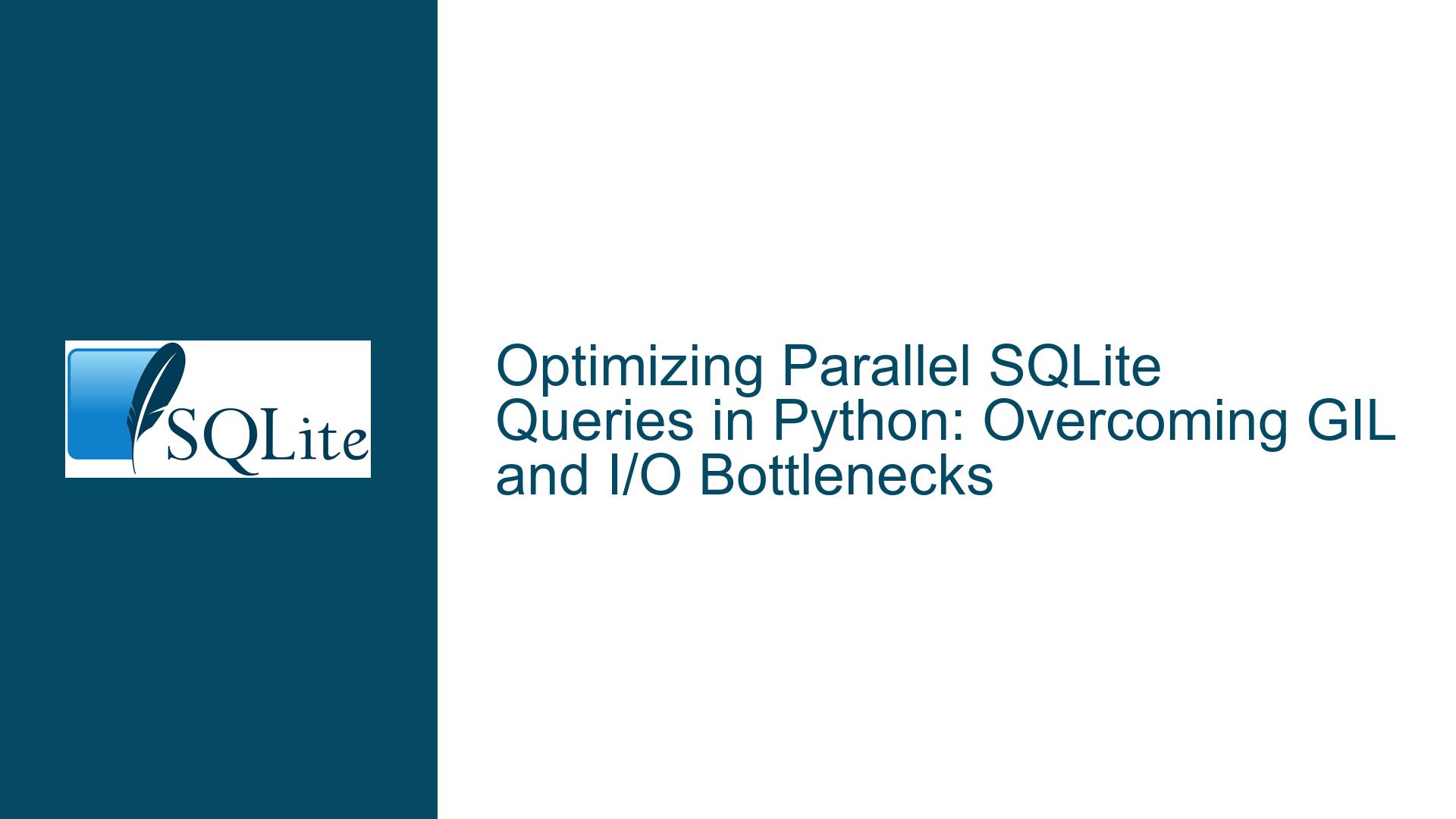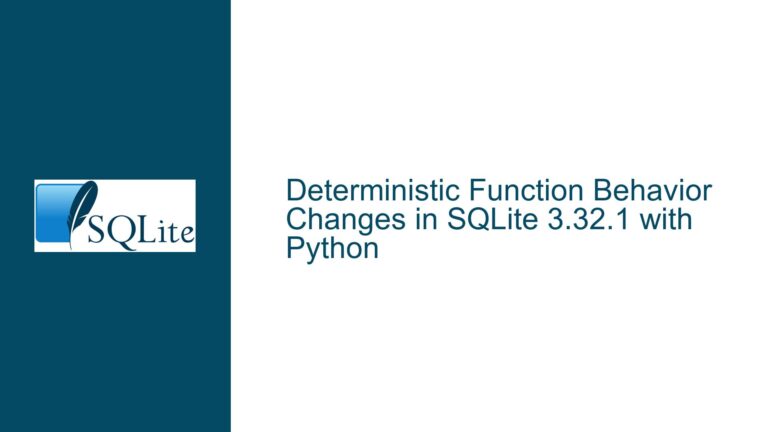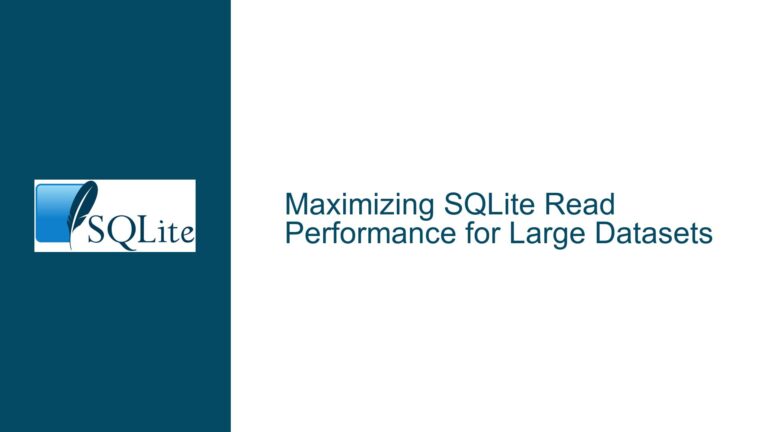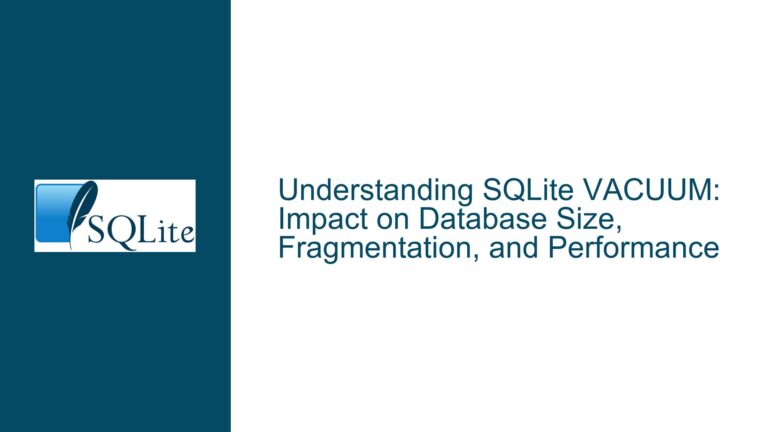Optimizing Parallel SQLite Queries in Python: Overcoming GIL and I/O Bottlenecks
Understanding the Performance Impact of Parallel SQLite Queries in Python Applications
The challenge of improving page load times by executing multiple SQLite queries in parallel within a Python web application involves navigating a maze of concurrency models, hardware limitations, and database engine internals. When aggregations like count(*) on million-row tables or complex group by operations dominate page rendering time, developers instinctively reach for parallel execution strategies. However, the interplay between Python’s Global Interpreter Lock (GIL), SQLite’s locking mechanisms, and storage I/O characteristics often negates expected performance gains. This guide dissects the root causes of suboptimal parallel query performance and provides actionable solutions to unlock true concurrency.
Diagnosing the Concurrency Bottleneck: GIL Contention vs. I/O Saturation
At the heart of the issue lies a conflict between Python’s threading model and SQLite’s architecture. Python threads appear to execute concurrently, but the GIL ensures only one thread actively executes Python bytecode at a time. While SQLite’s C internals release the GIL during query execution (allowing CPU-bound operations to leverage multiple cores), the Python layer regains the GIL when processing result sets. This creates a "bottleneck sandwich": parallelized SQLite C code bookended by serialized Python result handling.
Simultaneously, storage I/O emerges as a critical factor. Even with the entire database cached in the kernel’s page cache (common for read-only datasets under 100MB), SQLite’s page-level locking and filesystem metadata operations introduce contention. Concurrent threads accessing overlapping database regions trigger subtle synchronization overhead, while SSDs and NVMe drives mitigate – but do not eliminate – latency from parallel read requests.
Key questions to resolve include:
- CPU Saturation: Are queries truly CPU-bound (e.g., complex aggregations with unindexed columns) or merely waiting on I/O?
- GIL Impact: Does result set processing in Python dominate query runtime, negating parallel execution benefits?
- Locking Overhead: Are multiple connections contending for SQLite’s write-ahead log (WAL) or shared cache locks?
Mitigating Python and SQLite Concurrency Constraints
1. Global Interpreter Lock (GIL) Contention During Result Processing
- Mechanism: The
sqlite3module releases the GIL during raw SQL execution (e.g.,cursor.execute()), but reacquires it when converting SQLite’s C-level result rows into Python objects (e.g.,Rowinstances). For result sets with millions of rows, this serializes what should be parallelizable work. - Detection: Profile CPU utilization during parallel query execution. If one core remains saturated while others idle, GIL contention is likely. Alternatively, compare execution time for a single thread processing all queries versus multiple threads using the
nogilPython fork (e.g., colesbury/nogil). - Example: A query returning 1M rows spends 10ms in SQLite aggregation (parallelized across cores) but 200ms in Python row object creation (serialized by the GIL). Parallelizing such queries yields minimal gains.
2. Storage I/O and SQLite Locking Overhead
- Page Cache Utilization: Even with the database fully cached in memory, SQLite’s locking protocol requires acquiring shared or reserved locks on the database file. Concurrent readers using separate connections contend for these locks, introducing latency proportional to the number of parallel queries.
- WAL Mode Trade-offs: Enabling Write-Ahead Logging (via
PRAGMA journal_mode=WAL;) allows concurrent reads but requires careful tuning of thewal_autocheckpointsetting. Overly aggressive checkpoints during parallel query execution can stall readers. - File Copy Strategies: Duplicating the database file (
cp database.db database_1.db) and opening separate connections to each copy eliminates lock contention but complicates cache locality. The kernel may load identical pages from multiple files into memory, wasting cache space.
3. Suboptimal Query and Schema Design
- Full Table Scans:
count(*)on unindexed tables forces SQLite to scan every row. Parallelizing such queries exacerbates I/O contention as multiple threads compete for the same pages. - Index Utilization: Queries with
group byclauses on unindexed columns trigger temporary table creation and sorting, which are CPU-intensive but not always parallelizable within SQLite’s execution engine. - Connection Overhead: Each Python thread maintaining a separate SQLite connection incurs memory and setup costs. Connection pooling (e.g.,
sqlite3.connect(':memory:?cache=shared')) mitigates this but requires careful transaction handling.
Strategic Solutions for Maximizing Parallel Query Throughput
1. Bypassing GIL Limitations with Process-Based Parallelism
- Multiprocessing Module: Replace threads with processes using
multiprocessing.Pool. Each process has its own GIL, enabling true parallelism. Caveats:- Result Serialization: Return large result sets as lists of tuples instead of
sqlite3.Rowobjects to minimize pickling overhead. - Database Copies: For read-only workloads, preload the database into each process’s memory using
conn = sqlite3.connect('file:db?mode=ro&cache=shared', uri=True).
- Result Serialization: Return large result sets as lists of tuples instead of
- Example Implementation:
from multiprocessing import Pool import sqlite3 def run_query(query): conn = sqlite3.connect('file:my_db?mode=ro&cache=shared', uri=True) conn.row_factory = sqlite3.Row # Avoid if pickling fails return conn.execute(query).fetchall() with Pool(4) as pool: results = pool.map(run_query, ['SELECT count(*) FROM t', ...])
2. Optimizing SQLite for Concurrent Read-Only Workloads
- WAL Mode Configuration:
PRAGMA journal_mode=WAL; PRAGMA wal_autocheckpoint=1000; -- Minimize checkpoint stalls - Shared Cache Connections: Use
cache=sharedin the URI to allow connections within the same process to share memory pages:conn1 = sqlite3.connect('file:db?mode=ro&cache=shared', uri=True) conn2 = sqlite3.connect('file:db?mode=ro&cache=shared', uri=True) - In-Memory Databases: For datasets under ~100MB, load the entire database into RAM using
sqlite3.connect(':memory:')andsqlite3_backup:import sqlite3 def copy_to_memory(disk_db): mem_conn = sqlite3.connect(':memory:') disk_conn = sqlite3.connect(disk_db) disk_conn.backup(mem_conn) return mem_conn
3. Reducing Python-Level Overhead
- Bulk Result Fetching: Use
cursor.fetchall()instead of iterating rows to minimize GIL reacquisition frequency. - Raw Cursor Output: Skip
Rowobjects by settingrow_factory=Noneand process raw tuples, reducing Python object creation overhead. - Cython Extensions: Implement result processing in Cython to bypass the GIL during deserialization:
# cython: boundscheck=False, wraparound=False from libc.stdint cimport uint64_t def sum_counts(cursor): cdef uint64_t total = 0 for row in cursor: total += row[0] return total
4. Hardware and OS-Level Tuning
- Kernel Page Cache Pressure: Monitor
sar -Bfor page cache misses. Increasevm.dirty_ratioto 40% (default 20%) if evictions occur during query bursts. - File System Mount Options: For ext4, use
noatime,nodiratime,data=writebackto minimize metadata updates. Avoidbarrier=0unless data loss is acceptable. - SQLite Page Size: Match the database page size to the filesystem block size (typically 4KB) using
PRAGMA page_size=4096;before creating tables.
5. Query and Index Optimization
- Covering Indexes: Replace
count(*)with precomputed totals stored in asqlite_stat1-style table, updated via triggers. - Materialized Views: For frequent
group byqueries, create indexed temporary tables refreshed on transaction boundaries:CREATE TEMPORARY TABLE daily_counts AS SELECT date(timestamp) AS day, count(*) AS n FROM events GROUP BY day; CREATE INDEX idx_daily_counts_day ON daily_counts(day); - Approximate Counts: Use
sqlite3_total_changes()or probabilistic counters (HyperLogLog) when exact counts aren’t critical.
Final Recommendations for Production Deployments
- Benchmark with Realistic Data: Profile both synthetic and production datasets to identify whether bottlenecks are CPU-bound (GIL), I/O-bound (storage), or lock contention.
- Hybrid Approach: Use threads for I/O-bound queries (e.g., waiting on WAL checkpoints) and processes for CPU-bound aggregations.
- Monitoring: Track SQLite’s
sqlite3_status(SQLITE_STATUS_MEMORY_USED)andsqlite3_db_status(db, SQLITE_DBSTATUS_CACHE_USED)to detect memory pressure. - Failover to Serial Execution: Dynamically switch to serial query execution when the database exceeds available RAM or concurrent user load spikes.
By systematically addressing GIL contention, SQLite locking semantics, and storage I/O characteristics, developers can achieve substantial performance improvements—even for complex analytical queries on large datasets. The optimal strategy often combines process-level parallelism, schema optimizations, and OS-level tuning tailored to the specific workload and hardware profile.






